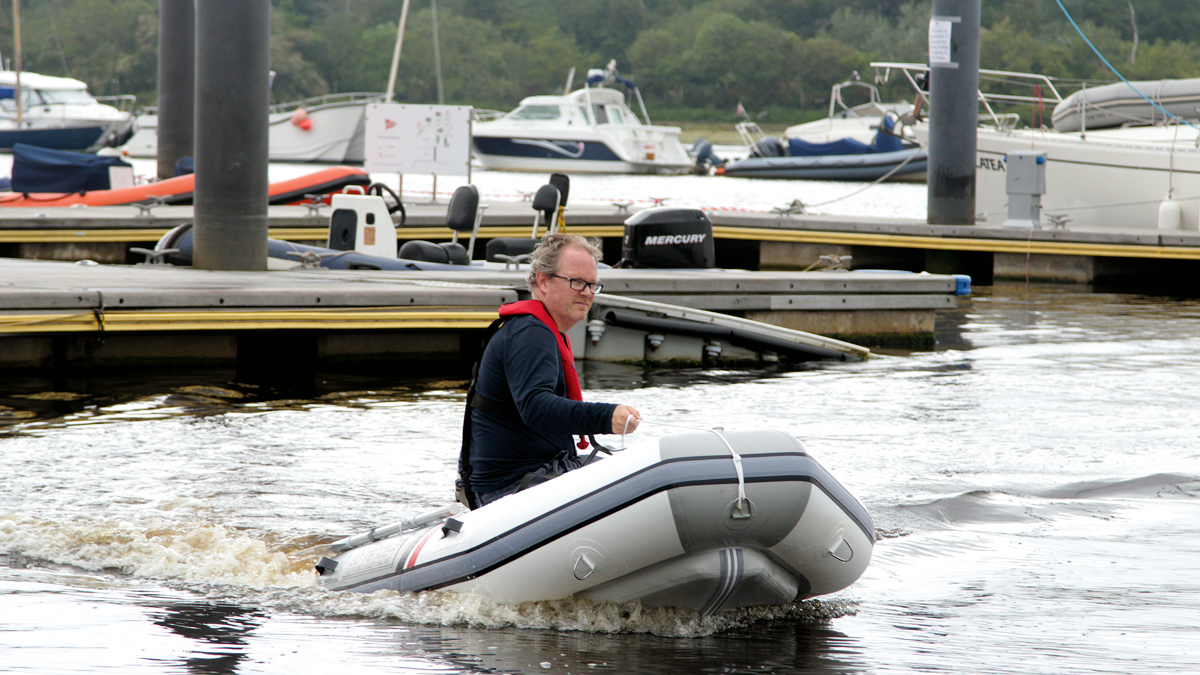We’ve joined forces with Practical Boat Owner to test out seven of the best small inflatable air deck tenders.
Even small motor boats usually need to carry some form of tender, but unless your boat is big enough to carry a mini RIB or jetski that almost certainly means investing in some form of inflatable dinghy that is compact enough to pack neatly away in a lazarette when not in use.
These used to be fairly crude devices with wobbly, flat slatted floors and saggy tubes, but thanks to the invention of the high-pressure air deck, the latest generation of lightweight inflatable tenders are remarkably stable craft that can be rowed or powered by an outboard engine yet can still be easily stowed on boats under 30ft.
So who makes the best ones and what should you be looking for to get maximum value for money? We tested seven different 2.3m to 2.4m inflatables tenders – all with air deck floors that don’t take up too much space when deflated and packed away.
Some also had inflatable keels or vee-shaped bottoms, which gave them a noticeably drier ride through waves and much better directional stability, especially under power.
We rowed and motored all of the boats solo and with two aboard, as well as weighing, measuring and comparing specifications.
Article continues below…

Best small outboard motors: Electric vs petrol in head-to-head group test

Toy of the month: Yamaha YAM TAf aluminium-hulled tenders
Things like the size, shape and quality of the carry bag as well as the pumps supplied can also make a surprising difference to the speed and ease of inflating and deflating each tender.
And while it’s tricky to make any objective measurements of build quality and durability, we did take note of features like keel strips and rubbing strakes, which should reduce wear and tear, as well as safety lines and bow handles that make them easier to lift and carry.
Finally, we assessed the relationship between price, weight and fit-out before picking our winners.
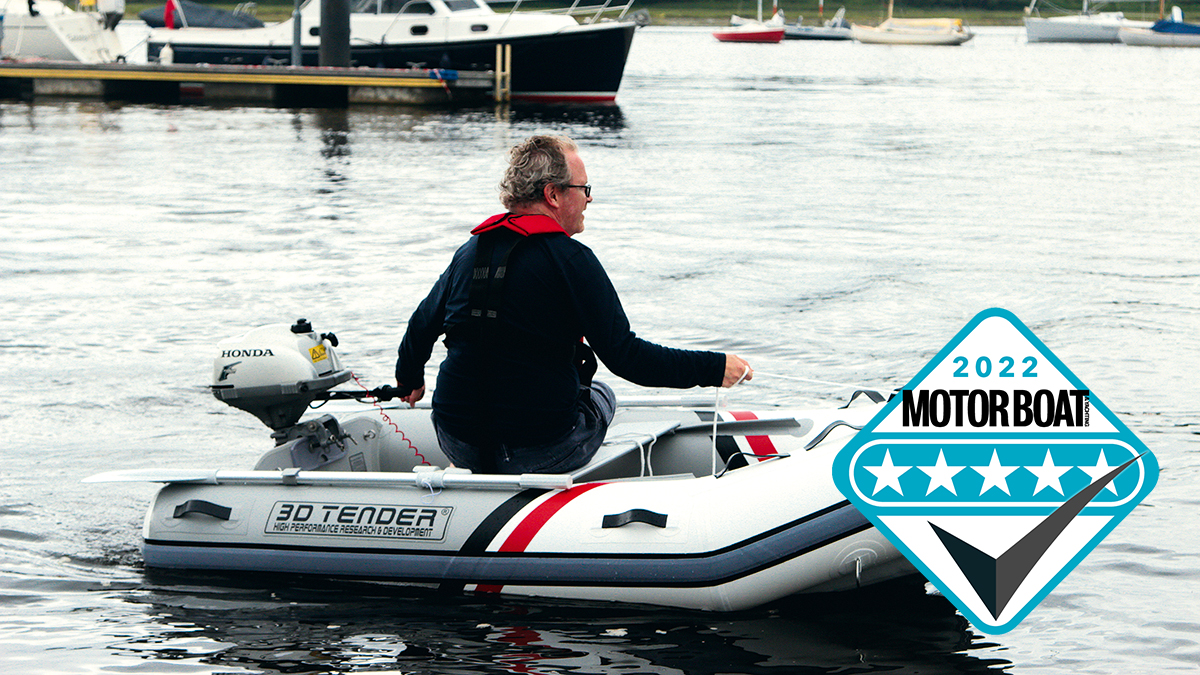
Multiple handles make it easy to lift out of the water and carry between two people, while the V-shaped hull makes for a drier ride and easier steering
3D Twin V-Shape 230 Air Deck
French manufacturer 3D Tender was one of the earliest producers of ultralight inflatable tenders. This model sports premium touches, such as davit rings and the most high-spec pump of all the boats on test.
In terms of convenience it packs away into a rucksack carry bag with a large front pocket for the pump and accessories. The zips will need maintenance though.
The inflatable V hull makes for a dry, stable ride with easy handling under engine or oars, and uses a single-chamber design, reducing set-up time to a minimum and keeping the weight down.
The lack of safety lines on the side makes carrying as a two-person team a little less convenient than some of the other boats but the keel strip will help protect it when being hauled up beaches and rough concrete slipways.
The rowlocks double as cleats and the rubbing strake provides extra strength and protection for the tubes, but little in the way of splashproofing for passengers.
Overall a high-quality tender that performs well and strikes a good balance between weight, convenience and price.
Specifications
Inflated size: 230cm x 130cm
Packed size: 90cm x 45cm x 40cm
Weight overall: 24kg
Floor type: Single-chamber V-floor
Max engine: 3.5hp
Max load: 350kg
Speed with 2.3hp: 4.2 knots (solo)
Price: £669
MBY rating: 5/5
Buy it now on oceanfirstmarine.co.uk

Sponson caps mean it can stowed upright without damaging the tubes, while the rubbing strake is shaped so that it doubles as a spray deflector
Crewsaver Air Deck 230
The pack we were sent for testing had the incorrect seat included but we were able to substitute a seat from one of the other boats on test without difficulty.
The rucksack doesn’t have a front pocket for storing accessories but there are no zips to corrode and the adjustable webbing buckles mean the top opening of the bag is quite forgiving for repacking.
The safety lines are robustly attached to the hull, which is a feature that will pay dividends long-term but adds a bit of weight. The rubbing strake also adds durability while the splash guards help keep water out of the boat.
The coned aft sponson caps are made from hard plastic, enabling vertical storage without damage. The rowlocks also double as cleats.
There are davit rings in the bow and through the thick transom board, plus the bow handle is wide for ergonomic carrying.
The inflatable deck feels sturdy enough but lacks the V shape or inflatable keel meaning it’s not quite as comfortable in a chop. This is a smart little tender with plenty of good features and an attractive price.
Specifications
Inflated size: 230cm x 130cm
Packed size: 95cm x 55cm x 35cm
Weight overall: 23kg
Floor type: Flat air deck
Max engine: 4hp
Max load: 350kg
Speed with 2.3hp: 4.8 knots solo
Price: £470
MBY rating: 4/5
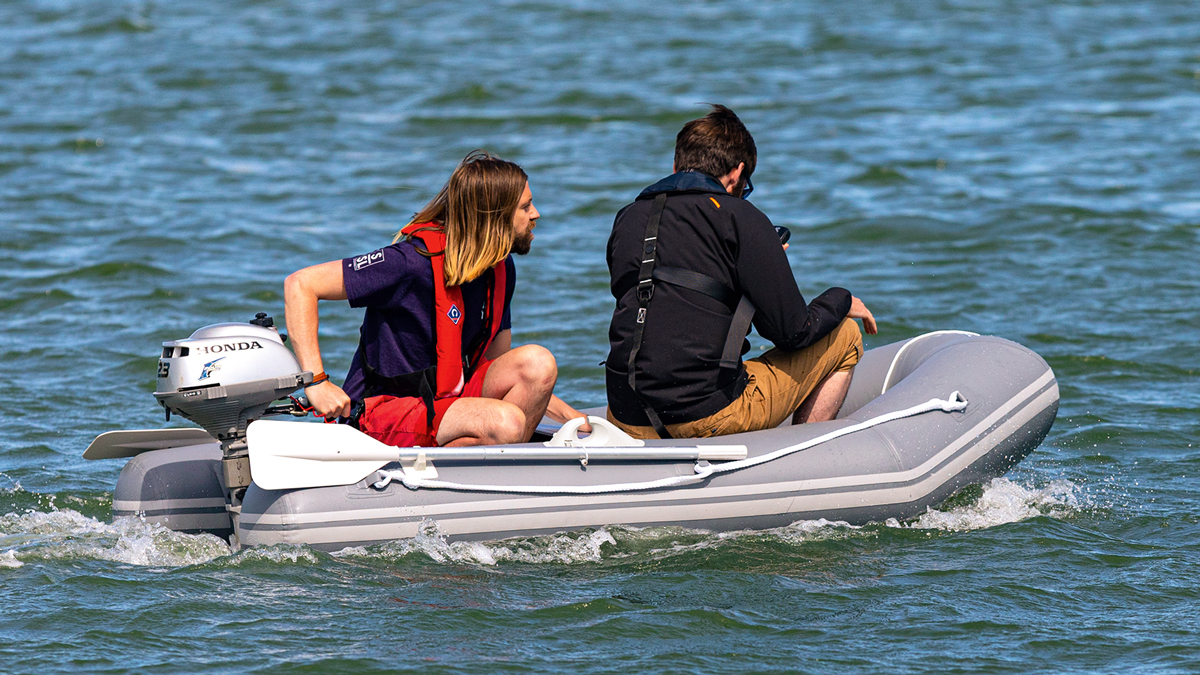
Limited max load of 284kg is the downside of its small size and weight. Short oars make rowing hard work, but open rowlocks allow for easy replacement
Force 4 02 Lite
This model is very similar to the Seago Go Lite, including the rucksack, which was our favourite on test for carrying comfort, although you do have to beware of any loose objects inside the bag dropping out of the side enclosure flap.
The Force 4 02 Lite was the lightest package overall and packed down to just 90cm long, making it easy to lift on and off the bathing platform as well as stow away in a locker.
The oars were the smallest on test, which affected the rowing performance, but it was the only boat with open rowlocks – so you can easily replace them with bigger and better oars.
The bench has a limited amount of adjustment, but we weren’t able to position it far enough aft to brace our feet against the transom under oars.
There are three D-rings for making a towing bridle on the bow but no ergonomic handle for dragging it up the beach.
The rubbing strake is minimal with no splash guard and the floor is flat rather than V-shaped, so although it was the quickest on test under power, it may not be the driest or most robust. There are no davit lifting eyes either.
Specifications
Inflated size: 230cm x 130cm
Packed size: 90cm x 50cm x 30cm
Weight overall: 17.5kg
Floor type: Flat air deck
Max engine: 4hp
Max load: 284kg
Speed with 2.3hp: 5.2 knots (solo)
Price: £500
MBY rating: 3/5
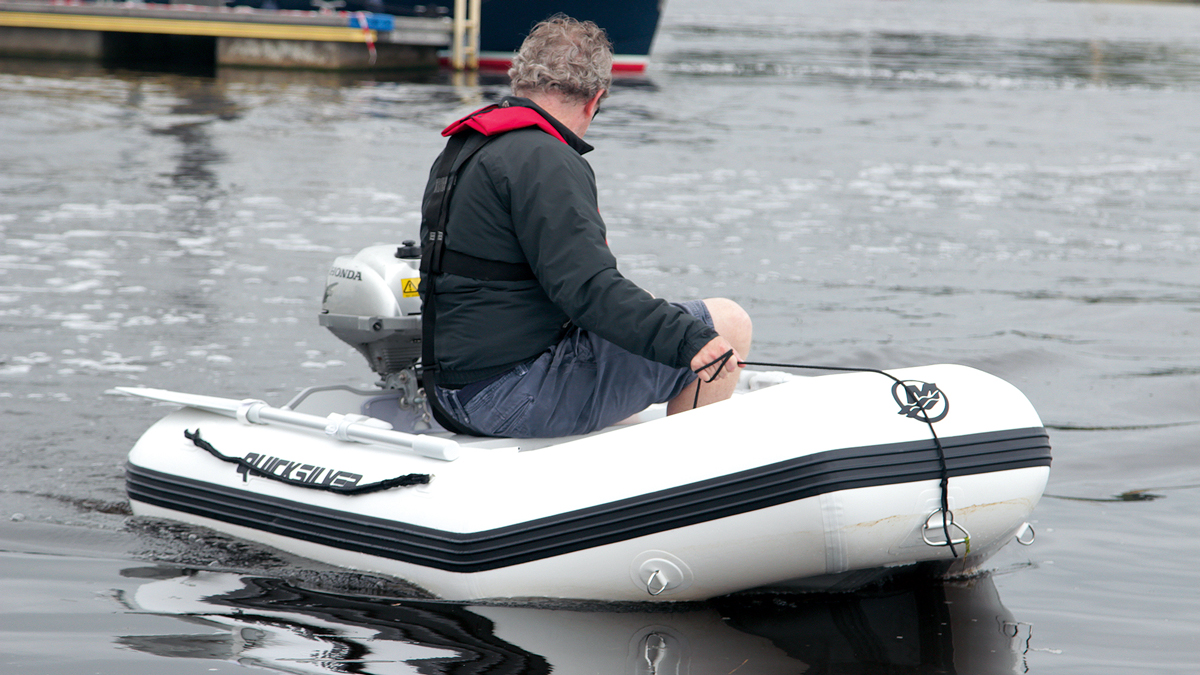
Towing rings mean you can spread the load by rigging up a v-shaped towing bridle. Wide bow handle makes it comfortable to lift and easy to drag up a beach on its robust keel strip
Quicksilver Tendy Airfloor 240
This boat has an inflatable keel as well as a removable inflatable floor. There was also a rigid slat athwartship between the floor and keel, which helps to maintain its shape and rigidity but increases the weight overall.
This is the heaviest boat on test and one of the largest in packed dimensions as well as being pricier than most. However, it is also one of the best equipped, looks very smart and feels well built.
It features a fuel tank strap, a robust keel strip to prevent damage on slipways, a decent bow carry handle and rowlock cleats.
The rubbing strake is quite meaty as well without being particularly splashproof. The carry bag is very forgiving, opening flat like a groundsheet then tightening up around the deflated tender.
There were no carry handles on the sponsons, and the safety rope fixings aren’t as solid as some of the other boats on test, although there are rowlock cleats and the seat is fully adjustable.
Another smart and robust-looking tender, albeit with a weight penalty attached.
Specifications
Inflated size: 240cm x 132cm
Packed size: 110cm x 50cm x 31cm
Weight overall: 28.5kg
Floor type: Inflatable keel
Max engine: 4hp
Max load: 390kg
Speed with 2.3hp: 4.2 knots (solo)
Price: £608
MBY rating: 5/5
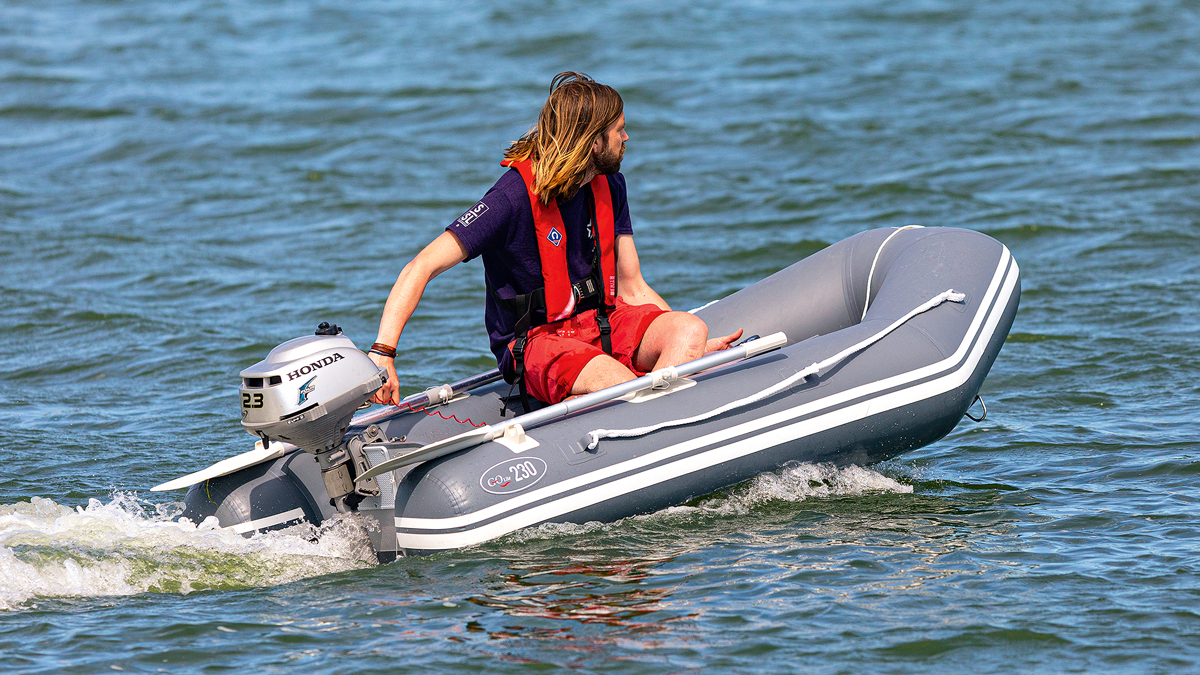
Rubbing strake provides limited protection against spray or tube wear and tear. Captive rowlocks are a mixed blessing when the oars are as short as this
Seago Go Lite 230
Seago is a distributor supplying UK chandleries. There are a number of similarities between this model and the 02 Lite from Force 4.
As the name suggests, this model is very light and compact – just 0.5kg heavier than the Force 4, but packs down to the same 90cm length.
The oars are very short, but are fixed using a pin and thole system which some may prefer over the Force 4’s rowlocks.
The PVC material is described as 1100 Decitex (Force 4’s O2 uses 800 Decitex), which means it should be marginally thicker and more durable, and helps to explain the slight extra weight over the Force 4 model.
The flat floors on both models made them wetter and trickier to steer under power than the ones with V-shaped bottoms.
Both come in identical backpacks that are very comfortable to carry and forgiving to repack due to their large side aperture rather than a narrow top.
Both are also supplied with foot pumps rather than our preferred option of a double-action hand pump. The rubbing strake is minimal and there is no ergonomic bow handle.
Specifications
Inflated size: 230cm x 135cm
Packed size: 90cm x 50cm x 24cm
Weight overall: 18kg
Floor type: Flat air deck
Max engine: 4hp
Max load: 270kg
Speed with 2.3hp: 4.5 knots (solo)
Price: £470
MBY rating: 3/5
Buy it now on seagoyachting.co.uk

Black tubes look very smart but could get hot in sunny weather. Long oars make this one of the easiest boats to row
Talamex Superlight SLA230
Talamex is a Dutch brand imported by EP Barrus. This boat had the narrowest diameter sponsons on test, which creates more internal space but less freeboard.
It’s a usefully lightweight package (19.67kg) with a thin transom board (rated to a maximum of 4hp) but nice long oars and a good carrying handle on the bow.
The pump supplied is a single-action hand pump and the bag folds out completely flat like a groundsheet, which is very forgiving for repacking. The bag has nice carrying handles on the narrow ends.
The seat was massively adjustable and the rubbing strake is generous without offering very much splash guarding. The safety rope attachments look a bit vulnerable and there are no other handles on the sponsons.
As with the Seago and Force 4 O2 models, it has a flat inflatable floor rather than our preferred V-shaped hull form and the black colouring of the tubes could make them uncomfortably hot in sunny Mediterranean conditions.
Specifications
Inflated size: 230cm x 135cm
Packed size: 90cm x 50cm x 25cm
Weight overall: 19.67kg
Floor type: Flat air deck
Max engine: 4hp
Max load: 325kg
Speed with 2.3hp: 4.8knots (solo)
Price: £600
MBY rating: 3/5

With the longest oars on test, this was the easiest boat to row. Inflatable keel creates a V-shaped hull for superior sea-keeping
YAM 240 (STI) Air Floor Sport
This is the most expensive model on test and features a separate inflatable keel and floor section in addition to two sponsons.
With that much to inflate a decent pump would have been better but there is a pressure gauge in the package to ensure everything is sufficiently firm.
The seat is fixed but the oars were nice and long, which made it the nicest boat to row. There were no safety lines fitted and the carry handles are spread far apart, which makes carrying it a little more awkward than it should be.
But there is a good, ergonomic bow lifting handle and the boat is rated for a load of up to 400kg, the highest rating on test.
The rowlocks double as cleats and the rounded aft end of the sponsons have protective, hard plastic caps.
A smart-looking boat that performed well and felt impressively stable with one or two people on board, but the price and substantial weight might count against it.
Specifications
Inflated size: 240cm x 123cm
Packed size: 120cm x 60cm x 30cm
Weight overall: 27kg
Floor type: Inflatable keel
Max engine: 5hp
Max load: 400kg
Speed with 2.3hp: 4.9 knots (solo)
Price: £818
MBY rating: 4/5
Buy it now on bhg-marine.co.uk
Our verdict
Our pick of the bunch is the 3D Tender, which manages to keep the weight down, comes complete with a high-spec pump, a user-friendly rucksack bag with a big front pocket, and features a V-form floor that inflates as a single chamber for speed.
It’s a pity there are no safety lines or a bow handle, so carrying the boat when inflated is less natural than some of the others, and it’s the second most expensive, but we still rate it as the best overall package.
The Quicksilver comes a close second, offering good build quality, a large payload and an inflatable keel at a mid-range price but at the cost of being the heaviest on test.
The Crewsaver is another strong contender with a good balance of price, quality, weight and features – the only thing lacking is a V-shaped hull.
The Yamaha 240 takes the dubious honour of being the most expensive and second heaviest on test but it does justify this by having the biggest payload, the highest engine rating, a V-shaped hull and the best oars as well feeling more robust than the cheaper models.
There is little to choose between the Talamex, Force 4 and Seago models. If size and weight are your top priorities then these are the lightest and smallest on test, and still perfectly good little tenders, although their maximum payloads do suffer as a result.
We marginally favour the Force 4 version because of its open rowlocks but if you prefer captive oars, the Seago is slightly cheaper. The final decision will come down to your own list of priorities.
See a comparison of the key facts and figures on pbo.co.uk
This version was first published in the March 2022 issue of MBY. Additional reporting by Rob Melotti and Toby Heppell.
If you enjoyed this…
Be first to all the latest boats, gadgets, cruising ideas, buying advice and readers’ adventures with a subscription to Motor Boat & Yachting. Available in both print and digital formats, our monthly magazine will be sent directly to your home or device at a substantial discount to the usual cover price. See our latest offers and save at least 30% off the cover price.










